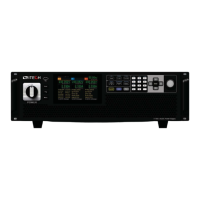Operation and Application
Copyright ©ITECH Electronic Co., Ltd. 36
Under DC+AC mode, Set the Vdc in the main interface, and set the Vac in the
configure menu.
Vdc: you can set the Vdc under the main interface or under the config interface.
Ripple control: set the wave,Vac component and frequency under the config
interface. The Vac setting range is 10% of rated voltage.
5.4 CV Mode/CC Mode and CP Mode
The IT7900 series power supply is constant voltage CV output mode by default.
Constant current CC and constant power CP modes can also be supported.
By default, the power supply will output a constant voltage according to the
voltage set value. Only when the output current is below the current limit value,
the power supply will output in constant voltage CV mode. However, when the
load current reaches the current limit value, after the delay interval, if the current
exceeds the current limit value, the power supply will switch to the CC mode and
the output current will be controlled to equal the current limit value. In the CC
mode, the voltage of the power supply will be reduced.
When the load power reaches the power limit value, after the delay interval, if
the power exceeds the power limit value, the power supply will switch to the CP
mode and the output power will be controlled to equal the power limit value. In
the CP mode, the voltage and current of the power supply will be regulated
according to power value.
CV/CC/CP modes will enter the corresponding mode as long as the conditions
are met first. The user cannot choose and set it on his own initiative.
The current limit value and power limit value can be set in the Protection menu.
Refer to 6.5 Protection Function for detailed setting methods.
5.5 Professional Anti-islanding Test Mode
The IT7900 series provide a professional anit-islanding test mode. Users can
adjust RLC parameters or configure the parameters of active power and reactive
power to simulate islanding status between inverter and load when the main
network is off, and verify the anti-islanding protection response time of grid-tied
DUTs under different equivalent impedances, three-phase load balancing and
non-balancing conditions.
The solution helps engineers to simplify the test circuit and cost savings of
additional equipment such as oscilloscopes and power meters.
1. Click the RLC function in Menu interface and enter to islanding simulator
function.
2. Select the mode.
z PQ mode: configure the parameters of active power(P), reactive power
Q
L
and Q
C.
z RLC mode: configure the parameters of R, L, C.
3. Close the K2 switch, connecting the load and UUT, and then close the K1
switch, power on the UUT.
4. Open the K1 switch, enable the islanding status. Test the anti-islanding
protection response time, The interface will display the running time value
in the island state.

